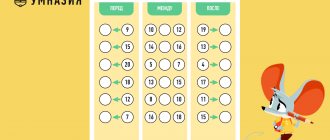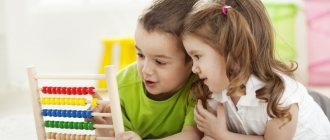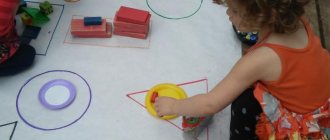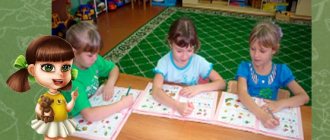How to teach a child numbers?
The sooner the learning process begins (especially in a home atmosphere), the easier it will be to achieve a positive result. The main thing is that it is interesting, entertaining and unobtrusive. It is not difficult to learn, since memorizing the number easily occurs during the game, using colorful pictures, vivid visual images, and favorite toys.
MAGAZINE Preschooler.RF
Lesson summary for the preparatory group “Composition of the number 5”Goal: to introduce children to the composition of the number five from two smaller numbers.
Tasks:
- introduce the composition of the number 5, that it consists of two smaller numbers
- strengthen the ability to name the number “one more”
- develop attention and memory, logical thinking.
Materials and equipment: multimedia presentation, three hoops, balls for each child with circles depicted on them, a large ball, a math set for each child.
Progress of the lesson:
Educator: Hello guys, please listen to the poem.
Let's guys learn to count! Remember everything that without an accurate count, no work will move forward. Without an account there will be no light on the street,
Without counting, the rocket won't be able to rise, And the kids won't be able to play hide and seek. Get to work guys quickly, learn to count so as not to lose count.
Tell me, what are we going to do today?
Children: Let's count.
Educator: That's right. But first I suggest you play. I will throw the ball and call the number, throwing the ball back to me, you will call the number one more. Three... (four), five... (six), eight... (nine), etc.
Game “Throw the ball and call the number”
Educator: Well done guys. Now let's go to the tables.
In front of each child there is a set of geometric shapes on the table.
Educator: Please look at the board (red squares appear on the screen one by one). Let's do the math with you.
The teacher and the children count squares 1, 2, 3, 4, 5.
Educator: Okay. Place 5 red squares in front of you.
Children lay out squares in front of them.
Educator: Now let's replace the last square with a yellow square. (Children change squares on the interactive board as desired) How many red squares are there in a row?
Children: Four.
Educator: How many yellow squares?
Children: One.
Educator: How many squares are there in total?
Children: There are five squares in total.
Educator: That's right. Four and one, and a total of five. Now count out three red squares and place them under the squares of the first row.
At this time, a number of squares are also displayed on the screen.
Educator: Now count out two yellow squares and place them next to the red ones. How many red squares?
Children: Three.
Educator: How many yellow squares?
Children: Two.
Educator: How many squares are there in total?
Children: There are five squares in total.
Educator: That means three and two, and a total of five. Now count out two red squares and place them under the squares of the second row. Fine. And three squares of yellow color and put them next to the red ones. How many red squares?
Children: Two.
Educator: How many squares are yellow?
Children: Three.
Educator: That means two and three, and a total of five. Now count out one red square and place it under the squares of the third row. Fine. And four squares of yellow color and put them next to the red one. How many red squares?
Children: One.
Educator: How many yellow squares?
Children: Four.
Educator: Correct. One and four, and a total of five. Now let's repeat all the options for the composition of the number 5.
Children: Four and one, three and two, two and three, one and four.
Educator: Absolutely right. Now I suggest you play a little.
Outdoor activity “Playing with apples”
There are hoops on the floor, at a distance from each other, with numbers in them (3, 4, 5). There are apples in the basket with circles (3, 4, 5) glued on them. At the teacher’s command, the children take any apple and start running to the music. As soon as the music stops playing, the children find the hoop with the desired number and stand near it. The game is repeated 2 - 3 times.
Educator: Well done guys. Oh, what is this on our screen?
Children: House.
A house with the number 5 appears on the screen.
Educator: Guys, let's remember what smaller numbers the number five consists of.
Children take turns calling to the multimedia board and clicking on empty windows located on the floors of the house.
Educator: You guys all did well today. What did we learn about today?
Children: About the fact that the number five consists of two numbers: 4 and 1, 2 and 3, 3 and 2, 1 and 4. Educator: Well done guys.
| Next > |
Mathematics for children. Where to start studying numbers
From the age of two, children's thinking develops at a rapid pace. Now is the time to introduce your child to simple math concepts and counting. Kids already know many geometric shapes and have an idea of shape and size. Educational games and exercises will help you become familiar with numbers and numbers.
If you study regularly, then by the age of three you will be able to develop the first mathematical skills:
- the baby will learn to count consistently from one to five;
- will understand the difference between the concepts “one” and “many”;
- will learn what the words “more, less, equally” mean, will get used to comparing groups of objects;
- remember the graphic image of the first five numbers, be able to recognize them on cards and compare them with the quantity;
- recognizes the signs “+” and “―”, learns to perform simple examples of addition and subtraction.
At first, the baby learns to count objects by pointing at them or touching them with a finger. This makes it easier to engage in visual-figurative thinking. To make counting a habitual activity, ask your baby to help you. Let him bring a certain number of spoons, apples, socks.
An indispensable condition for success is a good mood of the child and mother, praise for the efforts of the baby. When you notice signs of fatigue, take a break: let the baby jump, run, and rest. A quarter of an hour a day is enough for casual activities.
Step-by-step instructions for teaching your child to count
Adults think and perceive the world differently: some are better at working with images and objects, while others find it easier to navigate abstract mathematical categories. As for small children, everything is simpler: all of them, with rare exceptions, perceive the world through objects, and abstractions for the time being are beyond their understanding.
Therefore, in order to teach a child to count, it is necessary to operate either with the objects themselves or with their images. The first is preferable, since it is very important that the baby can not only see what he has to count, but also touch, smell and even, possibly, taste.
The reason lies precisely in the fact that he needs to link an abstract number with an object that is understandable to him, real and perceptible by all senses. These can be fruits, vegetables, candies, toys, and even your own fingers (in this case, of course, you shouldn’t try them on your teeth).
It is especially important to work with objects when you are dealing with very young children aged 1.5-2 years. Older guys are already excellent at using pictures.
"Dog and Cat"
You can start learning at about one and a half years old, but at this age, when the child still does not really know how to speak, you should not expect any outstanding results from him. Just introduce him to the concept of counting - lay out toys in front of him and say: “Here is one dog. But here is a dog and a cat” and so on. Give your baby a toy in each hand so that he subconsciously associates their number with the number of hands. In a word, prepare him for future training.
Count everything you see
From the age of three you can begin full-time education. And start with the simplest thing, with your fingers, because there are ten of them. From this age on, try to talk to your child about numbers as much as possible. These can be the simplest phrases: “We live on the third floor,” “We need bus number 15, and we get off at the fourth stop,” and so on. Ask your child to count all the objects he sees, as well as steps, steps and any actions he performs. At this stage of learning, it is already quite possible to work with pictures, so you can make special cards that will depict a different number of objects known to the baby: one apple, two plums, three berries. All kinds of counting poems are very useful at this stage - they are easy to remember, and counting is learned along with them.
In general, when starting to teach your child to count, remember two important things.
- Until about 5 years of age, a child cannot operate with abstract concepts, so counting must be tied to specific objects - real or drawn. For the same reason, do not try to immediately show your child writing numbers, at least until he begins to confidently count to 10 and solve simple addition and subtraction problems.
- Never scold your child for mistakes, but do not skimp on praise. Studying should evoke only positive emotions in him, and the approval of his parents gives him an incentive to study better.





